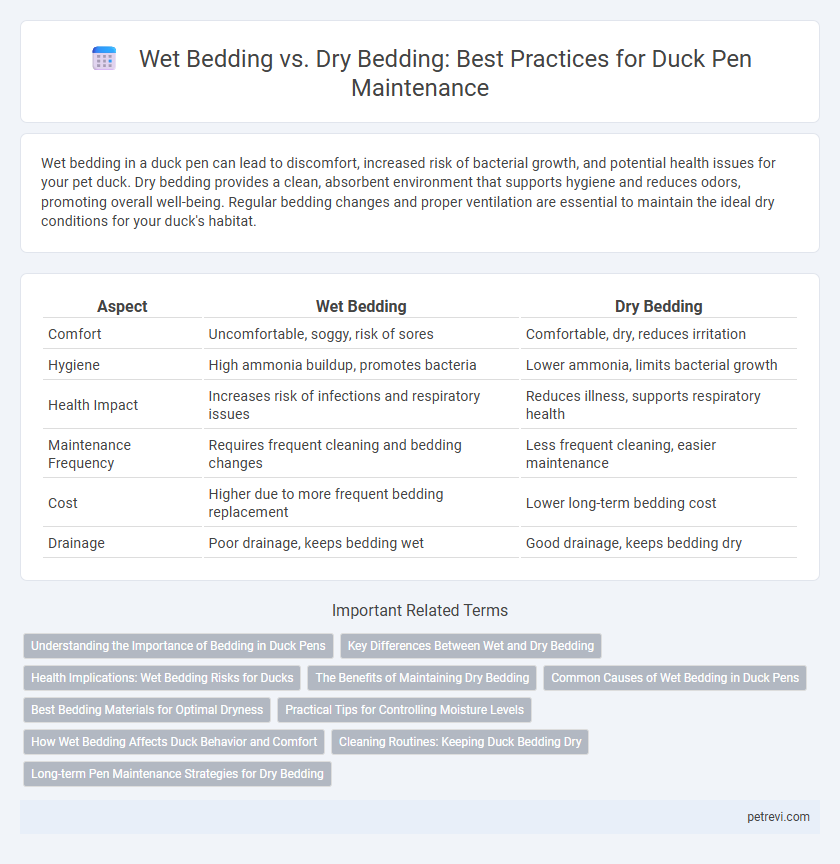Wet bedding in a duck pen can lead to discomfort, increased risk of bacterial growth, and potential health issues for your pet duck. Dry bedding provides a clean, absorbent environment that supports hygiene and reduces odors, promoting overall well-being. Regular bedding changes and proper ventilation are essential to maintain the ideal dry conditions for your duck's habitat.
Table of Comparison
| Aspect | Wet Bedding | Dry Bedding |
|---|---|---|
| Comfort | Uncomfortable, soggy, risk of sores | Comfortable, dry, reduces irritation |
| Hygiene | High ammonia buildup, promotes bacteria | Lower ammonia, limits bacterial growth |
| Health Impact | Increases risk of infections and respiratory issues | Reduces illness, supports respiratory health |
| Maintenance Frequency | Requires frequent cleaning and bedding changes | Less frequent cleaning, easier maintenance |
| Cost | Higher due to more frequent bedding replacement | Lower long-term bedding cost |
| Drainage | Poor drainage, keeps bedding wet | Good drainage, keeps bedding dry |
Understanding the Importance of Bedding in Duck Pens
Proper bedding in duck pens is essential for maintaining a healthy environment by controlling moisture levels and reducing ammonia buildup. Wet bedding fosters bacterial growth and increases the risk of foot and respiratory diseases in ducks, while dry bedding promotes cleanliness and comfort, supporting optimal duck health and growth. Regular maintenance with absorbent materials like straw or wood shavings ensures effective moisture management and enhances the overall welfare of the ducks.
Key Differences Between Wet and Dry Bedding
Wet bedding in duck pens often leads to increased ammonia levels and bacterial growth, causing respiratory issues and foot problems in ducks, whereas dry bedding promotes better air quality and reduces the risk of infections. Dry bedding materials like straw or wood shavings provide insulation and absorb moisture effectively, maintaining a healthier and more comfortable environment. Managing moisture by regularly replacing bedding prevents mold and supports duck welfare by minimizing stress and disease susceptibility.
Health Implications: Wet Bedding Risks for Ducks
Wet bedding in duck pens increases the risk of bacterial and fungal infections, leading to foot rot, respiratory issues, and skin irritations. Prolonged exposure to damp conditions also promotes parasites like mites and lice, compromising duck health and growth. Maintaining dry bedding prevents these health hazards, ensuring better overall hygiene and reducing veterinary costs.
The Benefits of Maintaining Dry Bedding
Maintaining dry bedding in a duck pen reduces the risk of bacterial and fungal infections, promoting healthier respiratory and skin conditions for ducks. Dry bedding also minimizes ammonia buildup, improving air quality and preventing harmful odors that can stress the flock. By absorbing moisture efficiently, dry bedding supports better insulation and comfort, leading to increased duck growth and overall productivity.
Common Causes of Wet Bedding in Duck Pens
Wet bedding in duck pens commonly results from poor drainage, excessive water spillage from drinkers, and inadequate ventilation leading to moisture buildup. Duck droppings combined with spilled water create a damp environment that encourages bacterial growth and ammonia accumulation, compromising both duck health and pen hygiene. Regular inspection of water systems, improved airflow, and prompt removal of soiled bedding help reduce wetness and maintain optimal conditions for ducks.
Best Bedding Materials for Optimal Dryness
Cedar shavings and straw are among the best bedding materials for maintaining optimal dryness in a duck pen, as they efficiently absorb moisture and reduce odor. Pine shavings also provide good moisture control but require careful sourcing to avoid harmful oils. Avoid using hay or untreated wood chips, which retain moisture and can promote bacterial growth, compromising duck health.
Practical Tips for Controlling Moisture Levels
Optimal duck pen maintenance demands controlling moisture levels by choosing dry bedding materials such as straw, wood shavings, or hemp fiber, which absorb water effectively and reduce odor. Frequent replacement or spot cleaning of wet bedding prevents harmful ammonia buildup and minimizes risk of foot problems and respiratory issues in ducks. Ensuring good ventilation and elevating bedding off damp ground further maintains dryness, promoting healthier living conditions for ducks.
How Wet Bedding Affects Duck Behavior and Comfort
Wet bedding in a duck pen can lead to increased moisture levels that promote the growth of harmful bacteria and fungi, negatively impacting duck health and comfort. Ducks exposed to damp and soiled bedding often display signs of stress and reduced activity, as wet conditions can cause foot lesions and discomfort. Maintaining dry bedding is essential to support natural behaviors such as foraging and resting, ensuring optimal welfare and preventing behavioral issues associated with poor pen hygiene.
Cleaning Routines: Keeping Duck Bedding Dry
Maintaining dry bedding in a duck pen is essential for preventing bacterial growth and minimizing ammonia buildup, which can harm duck health. Regular cleaning routines involve removing soiled material daily and adding fresh, absorbent substrates like straw or wood shavings to ensure moisture control. Proper ventilation and drainage systems further support bedding dryness, reducing illness risk and promoting a healthier environment for ducks.
Long-term Pen Maintenance Strategies for Dry Bedding
Choosing dry bedding such as straw or wood shavings in duck pen maintenance promotes better long-term hygiene by reducing moisture buildup and minimizing the risk of bacterial growth. Consistent removal of soiled bedding combined with regular fresh bedding replacement ensures a drier environment that supports duck health and prevents footpad dermatitis. Implementing proper drainage systems and airflow enhances dry bedding effectiveness, extending pen cleanliness and reducing maintenance frequency.
Wet Bedding vs Dry Bedding for Duck pen maintenance Infographic

 petrevi.com
petrevi.com